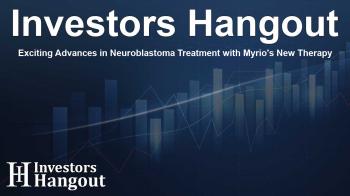Exciting Advances in Neuroblastoma Treatment with Myrio's New Therapy

FDA Approves Myrio's Innovative Therapy for Neuroblastoma
On a significant day for cancer treatment advancements, the U.S. Food and Drug Administration has granted approval for Myrio's investigational new drug (IND) application for its lead product, PHOX2B PC-CAR T. This decision paves the way for initiating human trials, signaling a hopeful step forward in the quest to treat neuroblastoma, a challenging childhood cancer.
Collaboration with Leading Children's Hospital
Myrio has teamed up with a premier children's hospital in their development efforts, working closely under the guidance of esteemed researcher Prof. John Maris. Together, they have made remarkable strides in the exploration of CAR-T therapy, intended specifically for neuroblastoma treatment. Their research identified the PHOX2B protein, which plays a crucial role in the biology of neuroblastoma cells, making it a prime target for immunotherapy.
The Significance of the PHOX2B Target
The innovation at the heart of this project is the design of a binder that targets the PHOX2B peptide, utilizing Myrio's proprietary ReD™ technology. What sets Myrio apart is that their binder can recognize this peptide across multiple HLA allotypes, which could enhance accessibility to treatment for a larger patient demographic. This capacity to break HLA restriction represents a groundbreaking approach in CAR-T therapy, as most traditional binders are limited in scope.
Promise for Neuroblastoma Patients
Myrio's research team has high hopes for the potential impact of this therapy. Prof. Maris emphasizes the urgent need for more effective treatment options for high-risk neuroblastoma patients, whose current therapies often lead to insufficient response rates and adverse side effects. The Phase 1 clinical trial titled "PHOX2B Peptide-Centric Chimeric Antigen Receptor Autologous T-cells (PHOX2B PC-CAR T) for Relapsed Neuroblastoma" represents an exciting opportunity to develop a new line of defense against this malignancy.
Anticipated Enrollment and Future Steps
The trial is expected to enroll its first patient by mid-2025. This initiative marks a significant milestone for Myrio, showcasing years of dedication and expertise in developing innovative treatments aimed at solid tumors.
Understanding Neuroblastoma
Neuroblastoma, accounting for a staggering 15% of pediatric cancer fatalities, is characterized as the most frequent tumor arising from the sympathetic nervous system. With around 800 new cases diagnosed annually, it commands attention for the critical need for advanced therapies. The variability of neuroblastoma presentation adds further complexity; symptoms can range dramatically from mild to severe depending on the extent of tumor dissemination.
Current Treatment Challenges
Patients classified as high risk face daunting challenges as the existing treatment landscape is beset with significant toxicity and limited efficacy. Striving for new alternatives is essential to improve survival outcomes for these children.
About Myrio
Myrio Therapeutics stands at the forefront of cancer research with its unique platform, Retained Display (ReD™). This innovative technology aims to uncover highly effective binders specifically targeting cancer cell proteins presented by the human leukocyte antigen (HLA) complex. Their approach promises a dual action: directing immune responses to tumor cells through bispecific T-Cell Engagers or enhancing CAR-T therapy efficacy by ensuring targeted cell elimination.
Frequently Asked Questions
What is the significance of Myrio's IND approval?
The IND approval allows Myrio to commence human trials for their innovative CAR-T therapy for neuroblastoma, marking a major step in cancer treatment advancements.
Who are the key figures behind the research?
Prof. John Maris is the leading figure in the clinical research collaboration between Myrio and a top children's hospital.
How does Myrio's therapy differ from traditional treatments?
Myrio's approach focuses on a specific protein target that can engage multiple patient populations, unlike conventional therapies limited to singular HLA types.
What challenges does neuroblastoma present?
Neuroblastoma exhibits a diverse range of symptoms and poses treatment challenges due to low response rates from current therapies, necessitating better options.
What is the next step after the IND approval?
The next step involves enrolling the first patient in the clinical trial, anticipated to begin in mid-2025, to assess the therapy's efficacy and safety.
About The Author
Contact Evelyn Baker privately here. Or send an email with ATTN: Evelyn Baker as the subject to contact@investorshangout.com.
About Investors Hangout
Investors Hangout is a leading online stock forum for financial discussion and learning, offering a wide range of free tools and resources. It draws in traders of all levels, who exchange market knowledge, investigate trading tactics, and keep an eye on industry developments in real time. Featuring financial articles, stock message boards, quotes, charts, company profiles, and live news updates. Through cooperative learning and a wealth of informational resources, it helps users from novices creating their first portfolios to experts honing their techniques. Join Investors Hangout today: https://investorshangout.com/
The content of this article is based on factual, publicly available information and does not represent legal, financial, or investment advice. Investors Hangout does not offer financial advice, and the author is not a licensed financial advisor. Consult a qualified advisor before making any financial or investment decisions based on this article. This article should not be considered advice to purchase, sell, or hold any securities or other investments. If any of the material provided here is inaccurate, please contact us for corrections.

